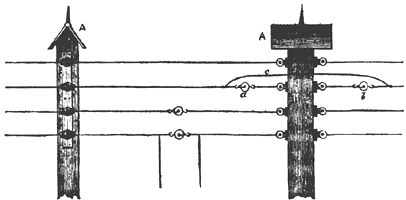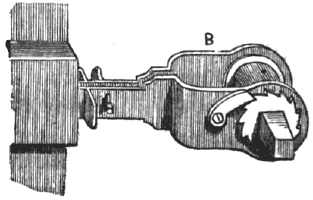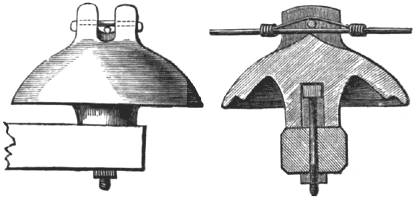[Book]
Publication: Manual of Electricity
London, England
p. 768-770; 788, col. 1
(1077) The modes of sustaining and insulating telegraphic wires adopted nearly universally in England are represented in Figs. 422 and 423. Wooden posts, from 15 to 30 feet high, are fixed firmly in the ground, at the rate of about 30 a mile ; the upper part of each post is 5 or 6 inches square; it carries a wooden arm, which is separated from the post by discs or rings of brown delf-ware. The arm is secured to the post by an iron bolt and screw. On the face of the wooden arm, 4 hollow double earthenware or glass cones are fastened by collars of iron; through these the wires pass, and are thus effectually insulated. A similar system of wires passes on the opposite side of the post, and each post is provided with a small roof of earthenware or slate, on the top of which is a metallic point connected with the earth as a preservative against the effects of lightning. The contrivance for tightening the wires is seen at B, The posts on which this apparatus is placed are much stouter than the ordinary sustaining posts, and they are fixed at intervals of ¼ th of a mile apart. To the upper part of the post are attached as many iron screws as there are telegraph wires, and each screw carries a winder, consisting of a grooved drum with a wheel and ratchet attached ; the ends of the winder are insulated from the post by discs of earthenware; a and b are two earthenware pulleys, or shackles, each furnished with two hooks insulated from each other. The winding post is thus seen to be out of the circuit, but the metallic continuity of the telegraph wire is secured by a thin wire, c, soldered to the outside of each shackle. The telegraph wire is of iron, about 1/6th of an inch in diameter: it is protected against the corroding action of atmospheric air and moisture by being passed through a bath of melted zinc, or galvanized, as it is called; zinc being more positive than iron, combines first with oxygen; the wire thus becomes coated with a thin layer of oxide of zinc, which acts as a coat of paint and effectually preserves the iron. In the neighbourhood of large towns, where great quantities of coal are daily burned, the sulphurous vapours arising from such fuel and passing over the oxide of zinc covering convert it into sulphate of zinc, which being soluble in water, is immediately melted by the rain and drops off. The wire thus deprived of its insoluble covering soon corrodes. Mr. Highton mentions ("Electric Telegraph," p. 117) that he has seen galvanized iron wires reduced in this way in less than two years from the diameter of 1/8th of an inch to that of a common sewing needle; and he suggests that in the neighbourhood of large towns the wires should either be painted and varnished, or entirely cased in gutta percha.
 |
| Fig. 422 |
 |
| Fig. 423 |
(1078) The insulator employed on the "Morse'' line from New York to Washington, is simply a glass knob with 2 rings, between which the wire is wrapped. It is said to be very imperfect (Turnbull on the "Electro-magnetic Telegraph," p. 176), the wire losing its insulation almost entirely in wet weather, and the instruments working with difficulty upon even the slightest shower. It has been found also, that with this form of insulator, the atmospheric Electricity cracks the glass in two pieces, just as if it had been cut with a diamond. In the "House" line of telegraph (American) the glass cap, which is covered with lac varnish, is screwed into a bell-shaped iron cap, which is filled with much care to the top of the post, and well painted and varnished, the telegraph wire is fastened to the top of the cap by projecting iron points. This plan, though decidedly superior to Morse's, is objectionable on the score of expense, and very inferior to the method adopted in England. In Germany, the wires are insulated by passing through porcelain caps, in the shape of a reversed cup, placed on the summit of the posts, which are thus covered with roofs. It is said to be very perfect.
The posts in France are from. 20 to 30 feet long, and are driven into the ground to a depth of from 30 to 60 inches, the buried parts being preserved by injection with sulphate of copper. The insulators, which are either bell-shaped or double oblique cones, are, as in England, fixed to the side of the post by screws, and sealed with sulphur in the interior; the conducting wire passes through a ring support fixed in the interior of the cone, so that the wire only passes on a point sheltered by the mass of the support.
When the conducting wires have to pass underground, they are usually made of copper, and are either covered with gutta percha or with cotton saturated with tar, and collected in leaden pipes in groups of three or four; the leaden pipes are covered with a pitched cord, and the whole placed in an iron pipe.
 |
| Fig. 432 and Fig. 433 |
In the overground system, the wires are arranged upon insulators attached to arms of different lengths, so that if a wire breaks and falls off it does not come into contact with those below, so as to impede the transmission of signals, but falls clear. The insulators are of glass or earthenware, of the form shown (side view and section in Figs. 432 and 433). The wires pass through a groove in the top of the insulator, and are secured there by a small peg and lapping of binding wire.
